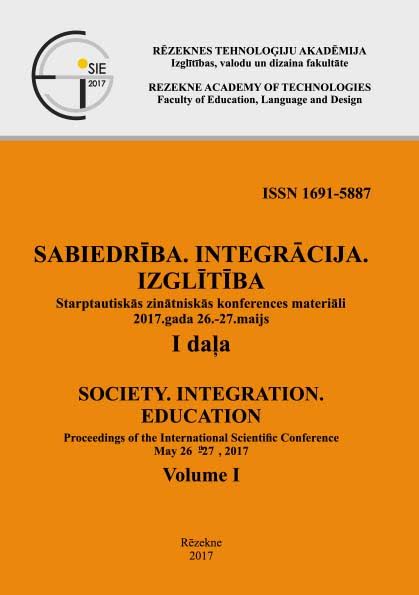INDIVIDUAL FUTURE ORIENTATION AND DEMOGRAPHIC FACTORS PREDICTING LIFE SATISFACTION
DOI:
https://doi.org/10.17770/sie2017vol1.2448Keywords:
demographic factors, future orientation, life satisfactionAbstract
This study explored a model of prediction of life satisfaction by individual future orientation (FO) and demographic factors. Individual views of the future and goals are closely associated with well-being. Theories of FO represent different approaches to its conceptualization. Following Seginer (2009), this study presents a combination of motivational, cognitive, and behavioral components of FO. Participants were 130 females and 75 males from 18 to 49. A new measure of individual FO (the Individual Future Orientation Scale, IFOS) and the Satisfaction With Life Scale (Diener, Emmons, Larsen, & Griffin, 1985) were used for the assessment. The results of structural equation modeling demonstrate that relatively higher life satisfaction is predicted by higher individual FO and higher income assessed as an income range and subjective satisfaction with it. Therefore, subjective involvement in a pursuit of future goals and financial background add to understanding of individual satisfaction with life.Downloads
References
Central Statistical Bureau of Latvia (2014). Income and living conditions in Latvia, 2013. Collection of statistical data (14). Rīga: CSB of Latvia. Retrieved from http://www.csb.gov.lv/sites/default/files/nr_14_ienakumi_un_dzives_apstakli_latvija_2013_14_00_lv_en.pdf
Diener, E. (1984). Subjective well-being. Psychological Bulletin, 95, 542-575.
Diener, E., Emmons, R. A., Larsen, R. J., & Griffin, S. (1985). The satisfaction with life scale. Journal of Personality Assessment, 49, 71-75.
Diener, E., Suh, E. M., Lucas, R. E., & Smith, H. L. (1999). Subjective well-being: Three decades of progress. Psychological Bulletin, 125, 276-302.
Drake, L., Duncan, E., Sutherland, F., Abernethy, C., & Henry, C. (2008). Time perspective and correlates of wellbeing. Time & Society, 17, 47-61.
Kolesovs, A. (2009). Factorial validity of the Latvian and Russian versions of the Zimbardo Time Perspective Inventory in Latvia. Baltic Journal of Psychology, 10, 55-64.
Kolesovs, A. (2015). Prediction of distant educational goals by goals in other domains and perceived contextual opportunities. In V. Lubkina, & S. Usca (Eds.), Society, Integration, Education: Vol. 4. Proceedings of the International Scientific Conference (pp. 40-47). Rēzekne: Rēzeknes Augstskola.
Krings, F., Bangerter, A., Gomez, V., & Grob, A. (2008). Cohort differences in personal goals and life satisfaction in young adulthood: Evidence for historical shifts in developmental tasks. Journal of Adult Development, 15, 93-105.
Ngoo, Tey, & Tan, (2015). Determinants of life satisfaction in Asia. Social Indicators Research, 124, 141-156.
Nurmi, J.-E., Salmela-Aro, K., & Aunola, K. (2009). Personal goal appraisals vary across both individuals and goal contents. Personality and Individual Differences, 47, 498-503.
Nuttin, J., & Lens, W. (1985). Future time perspective and motivation: Theory and research method. Leuven & Hillsdale, NJ: Leuven University Press & Erlbaum.
Rosseel, Y. (2012). lavaan: An R Package for Structural Equation Modeling. Journal of Statistical Software, 48(2), 1-36. http://www.jstatsoft.org/v48/i02/
Ryan, R. M., & Deci, E. L. (2001). On happiness and human potentials: A review of research on hedonic and eudaimonic well-being. Annual Review of Psychology, 52, 141-166.
Salmela-Aro, K., Pennanen, R., & Nurmi, J.-E. (2001). Self-focused goals: What they are, how they function, and how they relate to well-being. In P. Schmuck & K. M. Sheldon (Eds.), Life goals and well-being: Towards a positive psychology of human striving (pp. 148–166). Seattle, Toronto, Bern, Goettingen: Hogrefe.
Seginer, R. (2009). Future orientation: Developmental and ecological perspectives. New York, NY, Springer.
Seginer, R., Vermulst, A., & Shoyer, S. (2004). The indirect link between perceived parenting and adolescent future orientation: A multiple-step model. International Journal of Behavioral Development, 28, 365–378.
Upmane, A. (2010). Apmierinātību ar dzīvi prognozējošie faktori: kvantitatīva un kvalitatīva analīze [Factors predicting satisfaction with life: Quantitative and qualitative analysis] (Doctoral Dissertation, University of Latvia, Riga, Latvia).
Vandenberg, R. J., & Lance, C. E. (2000). A review and synthesis of the measurement invariance literature: Suggestions, practices, and recommendations for organizational research. Organizational Research Methods, 3, 4-70.
Zimbardo, P. G., & Boyd J. N. (1999). Putting time in perspective: A valid, reliable individual-differences metric. Journal of Personality and Social Psychology, 77, 1271-1288.


